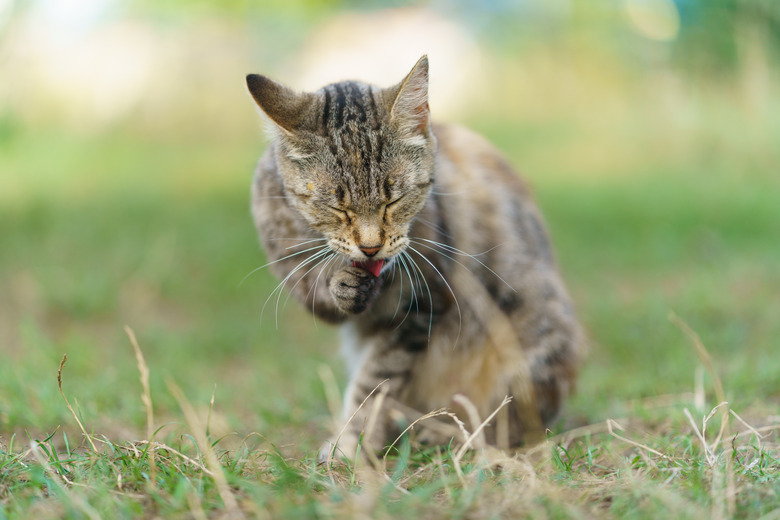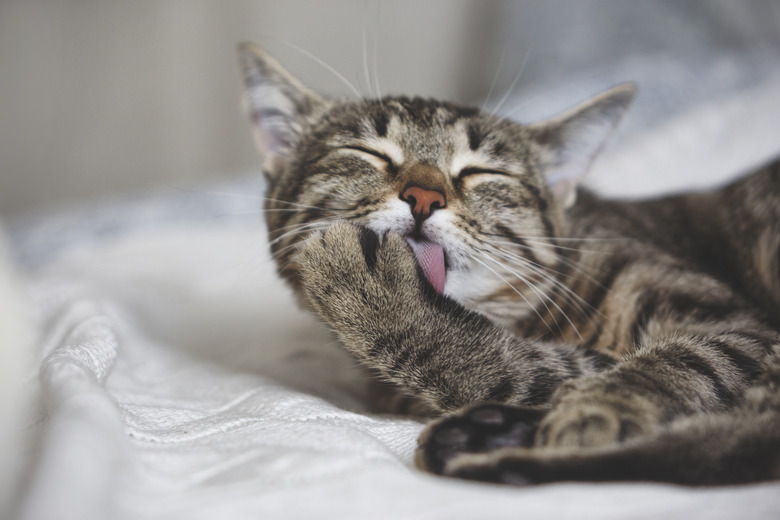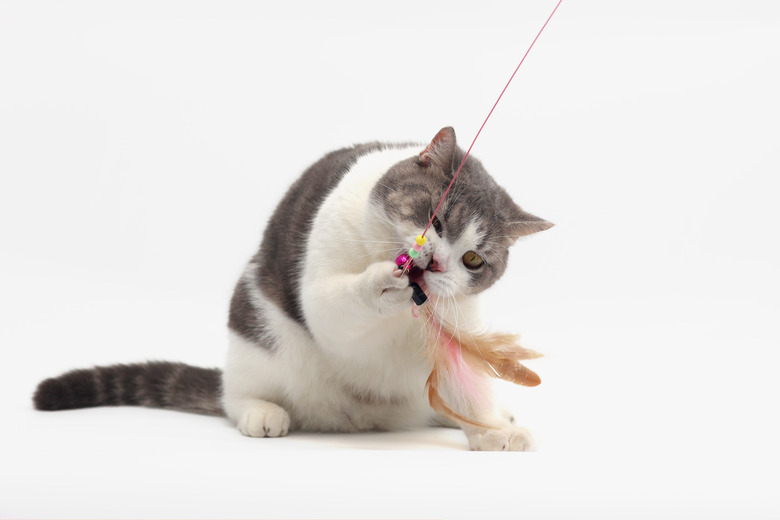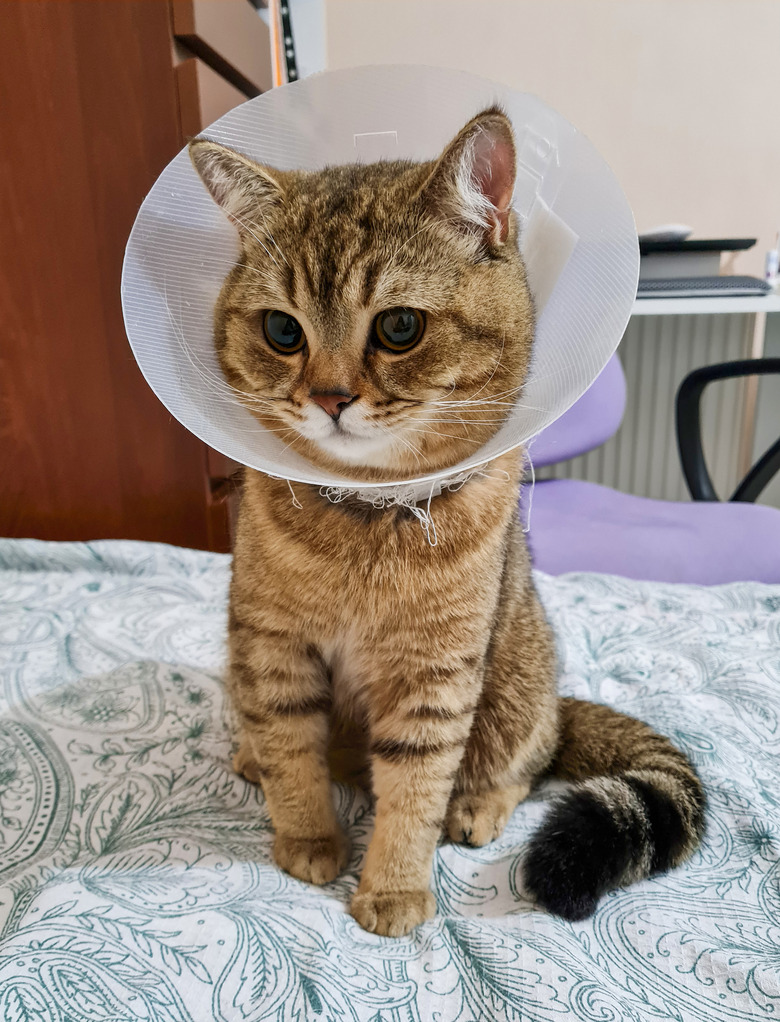How To Stop A Cat From Licking A Wound
- Why do cats lick wounds?
- Is cat saliva bad for cat wounds?
- Getting the right care for a cat's wound
- What happens when a cat's wound gets infected?
- Ways to keep cats from licking their wounds
- Cat lick deterrent
- How to keep a cat from licking stitches without a cone
- Using an e-collar as a cat lick deterrent
- The bottom line
As a loving cat owner, you do everything you can to help your cat recover from illnesses and injuries. If your cat has a wound, doing what's best for your cat may mean keeping them from licking the spot of the injury. This can be a bit of a challenge for pet owners, but with a little creativity, you can keep your cat from interfering with their wound's healing so they get better sooner. If you happen to have a pet first aid kit on hand with ointments or gauze wraps, you can do some simple wound care yourself.
Why do cats lick wounds?
Why do cats lick wounds?
Cats lick wounds for a number of reasons. A cat spay incision site that has been shaved and then stitched up can get itchy as your cat's hair starts to grow back. And if your cat has just received a fresh wound, they may lick it to remove dirt and clean the wound. Cats instinctively know that they need to lick away any blood so that they don't leave a trail behind that other predators could track.
While a cat who lightly licks a fresh wound, whether after surgery or after an open wound, can just be cleaning up, a cat who repeatedly licks a wound can be jeopardizing their ability to heal. Cats have papillae on their tongue, which makes it rough, and it can further irritate a surgery site or wound that's trying to heal. Because a cat's mouth contains bacteria, excessive licking of a wound can increase the risk of that wound becoming infected.
Cats can also become a little obsessed with licking their wounds and may actually slow their ability to heal. In these cases, you may need to step in and prevent your cat from licking their wound. Sometimes excessive licking is due to pain, so talk with your veterinarian if you notice your cat is repeatedly licking an area. They may need pain medication.
Is cat saliva bad for cat wounds?
Is cat saliva bad for cat wounds?
Cat saliva can be bad for cat wounds. While cat saliva is thought to have anti-bacterial properties, it is no substitute for veterinarian-prescribed antibiotics and antiseptics. The anti-bacterial properties of cat saliva are negligible compared to medications and to the amount of bacteria that licking can introduce to the wound.
Though licking open wounds is a natural behavior for cats in the wild, licking can also set up an infection, so it is best to prevent the action as much as possible. When your cat has an open wound, it is best to keep them distracted and in a position where they cannot lick the wound until they are seen by a veterinarian.
Getting the right care for a cat's wound
Getting the right care for a cat's wound
If your cat has a fresh wound, a veterinarian exam is ideal to be sure that the injury can be properly cared for. Small scrapes may just need to be cleaned up and held together with a little skin glue, but deep cuts may require a more thorough cleaning and some sutures to keep them closed. Puncture wounds can cause extensive damage under the skin, so your veterinarian will need to thoroughly clean, flush out, and treat these types of wounds.
Your veterinarian can help to assess the exact treatment that a wound needs and may decide to suture and bandage a wound to help it heal. During the appointment, the veterinarian may also administer pain or antibiotic medications to help keep your cat comfortable and healthy.
What happens when a cat's wound gets infected?
What happens when a cat's wound gets infected?
Occasionally, even the best care still results in an infection. Infection can go unnoticed for several days until your cat begins to run a fever, which can cause your cat to be unusually lethargic or to lick the infected area.
If an infection happens after veterinary care, check around the wound for pus or swelling, which can be signs of an abscess. Remember that wounds or scrapes from another animal should not be glued closed, as those injuries are more likely to become infected and potentially set up an abscess.
Ways to keep cats from licking their wounds
Ways to keep cats from licking their wounds
A simple way to keep cats from licking their wounds is to distract them with other amusements. Cat toys, particularly those filled with catnip, may be a welcome distraction from their discomfort. You can also sit with your cat and interrupt their licking. Simple redirection can be a low-impact way to keep your cat healthy in the days following their injury.
Of course, you cannot keep an eye on your cat at all times, and you may want to supplement redirection with some other methods, as described below.
Cat lick deterrent
Cat lick deterrent
If your cat is licking their wound, bandaging the wound can help to get them to stop. Your cat may simply decide to leave a bandage alone but make sure that the bandage remains dry and clean. If your cat is an indoor/outdoor pet, they should be kept indoors at all times while they're wearing a bandage. Plan to change the bandage daily and refer to your veterinarian for additional details about bandage care for your cat's specific wound. There are other options, such as a cat onesie, that pet owners can use to help the healing process.
In some cases, cats won't be deterred by bandages. Your cat may decide to lick or chew on the bandage, especially if their incision or wound is itching beneath it.
How to keep a cat from licking stitches without a cone
How to keep a cat from licking stitches without a cone
In addition to simply distracting your cat, which is difficult to do at all times, there are a few other methods you can try if your cat refuses an e-collar or an inflatable collar. Depending on where the wound is located, it is possible to cover the wound with a baby sock. Tape the sock to the cat's leg using pet-safe tape and remember to change the cover every day or so.
You can also use a bitter flavored bandage wrap. The unpleasant taste deters your cat from mouthing its wound while the flexible wrap holds gauze pads or other bandaging securely in place. Change the bandage daily.
Using an e-collar as a cat lick deterrent
Using an e-collar as a cat lick deterrent
When your cat licks the wound, distract them with treats or toys. However, this only works as long as you are present to catch your cat in the act. Because it's hard to constantly monitor your cat, you may need to use an e-collar — short for Elizabethan collar — to physically prevent them from licking the wound.
Many cats don't like e-collars, even soft e-collars, and your cat may try to remove the collar at first. However, your cat will probably settle down with a little time. For an e-collar to be effective, it needs to:
- Fit well and be long enough that your cat can't access their wound.
- Be snug enough around your cat's neck so they can't remove it.
- The traditional cone isn't the only option when your cat needs an e-collar. Many alternatives to the traditional cone now exist, made of different fabrics and shapes, some allowing cats to eat and drink while wearing them.
If your cat is wearing an e-collar of any sort, make sure they are continuing to eat and drink normally. If your cat is wearing a traditional e-collar (which purposefully extends beyond the face) make sure the e-collar isn't physically preventing your cat from reaching food and water in their bowls. Appetite is a good indication of health in cats, and even a few days of decreased eating can cause hepatic lipidosis, a serious condition, in some cats. The e-collar will stop your cat from licking the wound, but you can remove it during times when you're available to supervise your cat. Most wounds heal quickly, so you may only need to keep your cat from licking the wound for a few days or a week or two before they're all healed up.
The bottom line
The bottom line
Cats will naturally groom or lick a wound, but obsessive licking can lead to reopening a wound or it can create infection. Cats also have a rough tongue, so an e-collar or other method should be used to keep cats from reopening surgical or fight-inflicted wounds. If your cat doesn't take to an e-collar, you can try distracting the cat or covering the wound with a bandage or a baby sock held with surgical tape. If a wound shows signs of infection or if your cat seems feverish or lethargic, contact your veterinarian for followup care.



